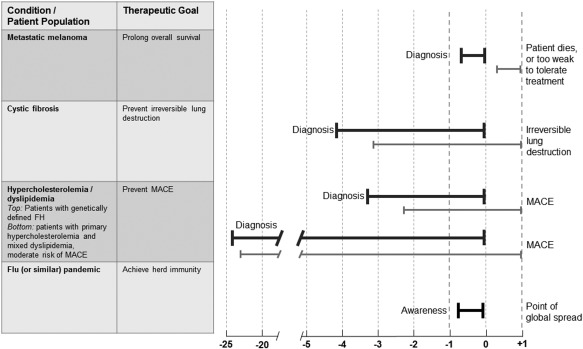Figure 1.

Treatment window of opportunity. The schematic illustrates why the time of access to a promising treatment is relevant to patients with any serious condition, independent of the time course of the disease.
Treatment windows of opportunity are shown for a few exemplary serious conditions ranging from very short (metastatic melanoma) to extremely long disease courses (primary hypercholesterolemia and mixed dyslipidemia). Estimates of windows are symbolized by bold horizontal lines, the start‐ and endpoints are described for each condition; the lengths of the lines are for illustration purposes only, and are not based on epidemiological data. Note that the time of the endpoint of the treatment window of opportunity may not be known for many health states (e.g., hypercholesterolemia) and the window period may in reality end long before the time of the events shown in the figure (e.g., because irreversible vascular damage has occurred before the MACE occurs). Nonetheless, all patients will eventually reach the endpoint of their treatment windows of opportunity; this is illustrated by the right‐alignment of the horizontal lines. The thin lines underneath each bold line are intended to show that each year a new cohort of patients with the same condition emerges and will reach the endpoint of their window 1 year after the previous cohort. This is true for all conditions where the year‐on‐year incidences remain relatively stable and in the absence of other emerging treatment options. The dashed vertical lines illustrate that a difference in time to market access of, for example, 2 years (year –1 vs. year +1) will have the same effect on patients with metastatic melanoma as for patients with hypercholesterolemia, insofar as the two annual cohorts of patients who are at the end of their treatment window of opportunity will gain or lose an opportunity to benefit from promising treatment. It follows that the time course of a disease per se should not be a driver of the evidence vs. access debate. The obvious but rare exceptions to this rule will be conditions with highly variable incidence rates. This is illustrated by the last example, flu (or similar) pandemic, where urgency of access is primarily determined by the anticipated time to peak global spread. The two different treatment window of opportunity lines under the “hypercholesterolemia/dyslipidemia” heading are intended to show that subgroups of patients within the same broad condition may have very different windows. FH: familial hypercholesterolemia; MACE: major adverse cardiac events.
